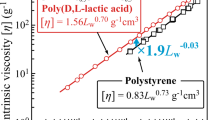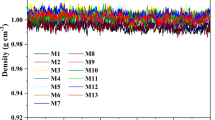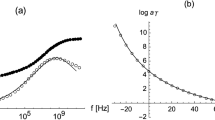Abstract
THE study of diffusion in solutions of natural rubber (light crepe) by Lamm's1 method showed that even with a concentration of 0·1 per cent the normalized experimental diffusion curves diverge from the ideal Gaussian curve (Fig. 1), being characterized by a marked asymmetry and an excess of the maximal ordinate. It follows from an analysis of the experimental curves by the method of moments (up to moments of the fourth order) that they belong to Type IV Pearson curves, that is, to asymmetrical distribution curves with asymptotic branches. The determination of the perturbation multiplier enables us to calculate the course of the experimental curves with a fair degree of accuracy. The physical cause of asymmetry of the diffusion curves is the difference in the rate of diffusion to both sides of the interface (of the polymer into the solvent and back) due to a marked intermolecular interaction in the solution of the polymer at a given concentration. With a decrease of the concentration or of the molecular weight of the dissolved substance, the asymmetry of the diffusion curves becomes less pronounced. However, this asymmetry does not preclude the computation of the average diffusion coefficient D from the standard deviation of the curve. It can indeed be shown that the probable error does not exceed 1 per cent. The average value found for natural rubber in carbon tetrachloride is D20° = 0·71 × 10â7 cm.2/sec.
This is a preview of subscription content, access via your institution
Access options
Subscribe to this journal
Receive 51 print issues and online access
$199.00 per year
only $3.90 per issue
Buy this article
- Purchase on Springer Link
- Instant access to full article PDF
Prices may be subject to local taxes which are calculated during checkout
Similar content being viewed by others
References
Lamm, O., Nowa Acta Reg. Soc. Scient. Uppsal., 10, No. 6 (1937).
Simha, R., J. Phys. Chem., 44, 25 (1940). Mehl, J., Oncley, J., and Simha, R., Science, 92, 131 (1940).
Campbell, H., and Johnson, P., Trans. Farad. Soc., 40, 221 (1944).
Frenkel, J., Acta Physicochim., 19, 51 (1944).
Polson, A., Koll. Z., 88, 51 (1939).
Cited in Davis and Blake, "The Chemistry and Technology of Rubber" (1937), 232.
Gehmann and Field., Ind. Eng. Chem., 29, 793 (1937).
Gralén, N., Koll. Z., 95, 188 (1941).
Author information
Authors and Affiliations
Rights and permissions
About this article
Cite this article
PASSYNSKY, A., GATOVSKAJA, T. Molecular Weight and Polydispersity of Rubber by Diffusion Measurements. Nature 157, 518–519 (1946). https://doi.org/10.1038/157518c0
Issue Date:
DOI: https://doi.org/10.1038/157518c0
Comments
By submitting a comment you agree to abide by our Terms and Community Guidelines. If you find something abusive or that does not comply with our terms or guidelines please flag it as inappropriate.



